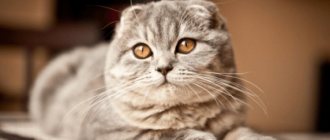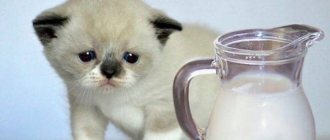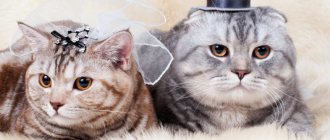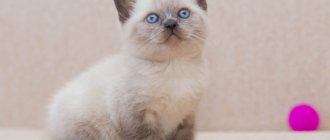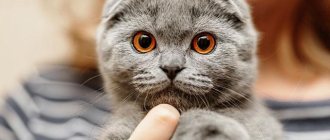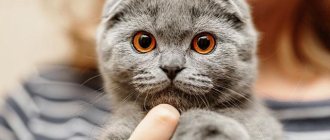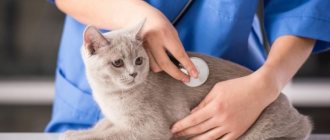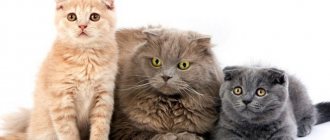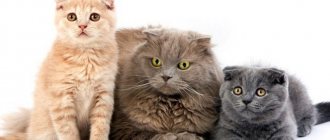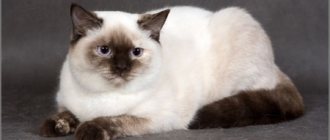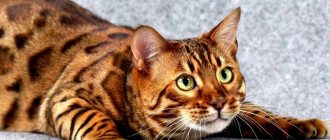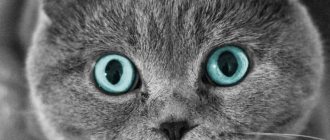For such representatives of the canine family, such as the Rottweiler, collie and Labrador, pug and fox terrier and many others, various forms of lop ears are not surprising, which cannot be said about cats. Fold cats, original in their kind, quickly won the attention of cat lovers. Thanks to this, the rather rare Scottish Fold has ceased to be a rarity, and has become not only very common, but also “reproduced”, which is something that lovers of purebred pets are somewhat unhappy about.
Scottish Fold cat: the origin and history of the breed
We can talk for a long time about how the Scottish Fold cat was bred, because the path is long. Contrary to the belief that the first fold-eared cat in the world is Susie, this is not so. No one knows how fold-eared cats appeared, but it was long before the history of Scotland. Susie only gave impetus to the development of the Scottish breed. Fold cats have been found in the wild for a long time: the first mention of them is in China. Only there it never occurred to anyone to breed tailed animals with such an interesting mutation. But Scottish farmers liked it so much that it was decided to give birth to a new breed. This happened in the 1960s, meaning the breed is considered relatively young. Farmer Mary Ross received the same Susie's daughter as a gift - a semi-wild white kitten - and immediately fell in love with him. It turned out to be a girl, who later also gave birth to a fold-eared kitten. Susie looked like this.
Article continues after advertisement
The first fold cat Susie: photo
And here is the exact place where it all happened.
The gift cat and her son were crossed with a cat and a cat of the British breed as the most similar to them. It is their children who are considered the first full-fledged representatives of the Scottish breed. The offspring resembled small cubs and owls due to the round shape of their heads. They appealed to the taste not only of ordinary people, but also of professionals.
Care features: combing and nutrition
There are no difficulties in caring for Scottish Fold cats. All procedures are standard and include combing, brushing teeth and ears, trimming nails and proper nutrition. Among pets there are animals with long and short hair; brushing is one of the important procedures for them.
Short-haired cats are brushed with a furminator 2 times a week, and long-haired cats are brushed daily, as the hair gets tangled and matted. This creates problems for the cat, so you should promptly pay attention to any hard hairballs that appear and remove them. Trimming cats' fur is not recommended. But trimming the claws is recommended 1-2 times a month with special clippers.
The Scots love a light massage; for this procedure it is recommended to use a rubber brush with round teeth so as not to injure the skin.
It is recommended to wash cats once every three months, using a special hypoallergenic shampoo with an anti-flea effect.
The peculiarity of the breed is in the ears, so special attention should be paid to the cleanliness of the ears. Due to the structure of the ears, wax accumulates inside, which is removed with a swab and ear drops. If the owner is not ready to carry out the procedure on his own, it is better to seek help from a veterinarian.
The Scottish Fold cat is quite large in size, so the tray and house should be chosen to make the animal comfortable. It is best to place the house in a warm place away from drafts, so that the cat does not have air.
The Scots do not like to walk, so you should not take your cat outside against its will. If the cat is kept in a private or country house, allow it to walk in the yard or garden under the supervision of the owner. Ensure physical activity by purchasing exercise equipment and play complexes with scratching posts, shelves, and posts.
It is important that the skeleton and muscle corset are trained and strong. This is especially important for those cats that become participants in exhibitions and compete for prizes.
It is acceptable to feed a Scottish Fold cat with prepared food or natural products. Beef, chicken, offal, and fish are boiled and form the basis of the diet. Additionally, it is recommended to give the cat some porridges - oatmeal, millet, rice, as well as cottage cheese and low-fat fermented milk drinks.
If you prefer to feed your pet with ready-made food, choose a premium class, which contains a completely balanced diet and contains all minerals and vitamins. Don't forget to leave clean water for your cat. If you are in doubt about what food to give, consult your veterinarian. Test results are sometimes required for better selection.
Problems with genes, or How was the Scottish breed developed?
The development of the Scottish breed was not all smooth sailing. Subsequently, it turned out that the lop ear gene was problematic. It is also called semi-lethal, because. Although it does not directly lead to death, it is a factor causing serious diseases of the musculoskeletal system. The fact is that the lop ear gene deforms the cartilage, as a result of which the ears fold and form a crease. But the rest of the bones and cartilage, under certain conditions, can also be damaged, up to the point where the cat loses the ability to walk.
Having learned about this, the professional community of Europe, without understanding the nuances, decided to ban the breed. In 1971, the largest feline organization in Great Britain outlawed the Scottish Fold.
Article continues after advertisement
The breed was saved by American scientists. The cats of the Scottish breed ended up overseas, where geneticist Rosemould Peltz found out that the Fd gene for lop-earedness is dominant, that is, it suppresses any gene that is paired with it. As a result, the offspring of two fold-eared Scots may develop serious deviations that are incompatible with a full life. But this applies to so-called homozygous animals that received two fold-eared genes, that is, Fd + Fd. The Scots, bred according to special rules recognized today throughout the world, do not have such problems.
This discovery allowed scientists to take a different look at the problem of this breed and develop breeding programs that obliged breeders to breed fold-eared cats only with straight-eared ones, as a result of which the offspring received different genes: Fd+fd (fold-eared cats) or fd+fd (straight-eared cats) . That is, the lop-eared Scots ended up receiving only one lop-eared gene, which most likely did not cause any complications. Straight-eared animals did not have the mutant gene in principle.
But the question remained: where to get straight-eared cats for crossing? For this purpose, in Europe the British breed was used as the closest to the Scottish one, and in America - the American Shorthair. The infusion of American Shorthair cat blood into the breed allowed breeders to lighten the skeleton of the Scottish cat, and therefore now the American type of Scottish cat is almost completely free of problems with the musculoskeletal system.
Having familiarized itself with the materials of geneticists and the experience of successful crossings, in 1976 the CFA registered the Scottish Fold breed, giving it the right to receive championship titles. At this point, the Scottish breed was again within the bounds of the law.
How to choose a kitten
Fold kittens are not rare; they are easy to buy in Russia. The prevalence of the breed is great; breeders can be found in every city, and nurseries can be found in big cities. The cost of kittens starts from 1.5 thousand rubles. The main thing is to know why the cat is being purchased.
If you do not plan to take your cat to shows or win medals, pay attention to the health, activity and appearance of the animal. Take the time to check the pedigree and make sure that you are buying a kitten of the right breed, and also get a health and vaccination certificate from the seller.
If the cat is needed for shows and exhibitions, you should study the proposed pet more carefully.
Buy a cat at the age of 3 months, this way all the external signs of the breed necessary for exhibitions will be better visible. The cat must be vaccinated, litter trained, have beautiful smooth fur, clean eyes, nose and ears. The shape of the ears of the Scottish Fold is usually distinguished by creases towards the forehead, but in small individuals the ears remain raised. They lower when the cat's head gets larger.
Pay attention to the tail: ideally it will be without kinks, straight and even. The cat's paws should also be free of knots, and the joints should be mobile and not enlarged.
Problems with recognizing straights
If everything is clear with folds since 1976 (the breed is recognized and legal), then they did not want to recognize short-haired straight-eared Scottish cats for a long time. Since British cats were used in the selection, the Scots turned out to be very similar to them. Folds had a difference in the shape of their ears, but straights did not have such a difference. Therefore, until 2004, Scottish Straights were always recorded as British.
However, in 2004, felinologists reconsidered their view. The fact is that the Scots, including the Scottish Straights, have a different character from the British, have a less heavy skeleton and have a number of differences in the structure of the skull. Having accepted these arguments, Scottish Straights were recognized as full-fledged Scots, although so far not all felinological organizations have done this.
And a little about secrets.
The story of one of our readers, Irina Volodina:
I was especially distressed by my eyes, which were surrounded by large wrinkles, plus dark circles and puffiness. How to completely remove wrinkles and bags under the eyes? How to deal with swelling and redness? But nothing ages or rejuvenates a person more than his eyes.
But how to rejuvenate them? Plastic surgery? I found out - no less than 5 thousand dollars. Hardware procedures - photorejuvenation, gas-liquid peeling, radio lifting, laser facelift? A little more affordable - the course costs 1.5-2 thousand dollars. And when will you find time for all this? And it's still expensive. Especially now. Therefore, I chose a different method for myself.
A caring owner is always interested in whether his pet is developing correctly. In order to notice alarming trends in time, it is necessary to track the weight of the Scottish kitten by month.
It is important that the Scottish cat’s food is balanced and served in accordance with the regimen. Obesity not only spoils the pet's appearance, but is also dangerous to the animal's health in all aspects. Your Scottish Fold or Straight will live a long and happy life if treated well and with care.
Modern type of breed
Today there are two genetic lines of the Scottish breed: European and American. The European line is built on crossing with representatives of the British breed. At some point, Persians and exotics also mixed in. European line Scottish dogs are larger and plusher.
In the USA, Scots are smaller, rather graceful animals with a long flexible tail, because. The selection involved medium-sized American shorthair cats. As a result, it was in America that they obtained such a variety as the Scottish Straight, crossing with which made it possible to obtain more flattened ears and a completely spherical head shape. But the lightening of the skeleton resulted in the fact that American-bred Scottish dogs are lighter and not so similar to bear cubs. But their ears fit much better.
There are also Scots with a muzzle of the old type, whose nose is wider and longer, and Scots of the new type, who have a small nose. The latter have childish faces.
However, no matter what line your Scotsie is, he will grow up to be a plush creature capable of love and affection for his owner.
Article continues after advertisement
The rate of weight gain in the first days of life
At this time, development occurs very quickly, every week the cubs weigh 10-20 grams more. The first month of life, kittens are helpless and do not leave their mother for long, feeding on her milk.
Up to two weeks, babies are blind and move little, actively gaining weight, which during this period is about 440 grams. Little cats begin to explore space and learn to control their bodies.
Proper development also depends on how the nursing cat eats. Buy high-quality food intended for the animal at a given period of life. The weight of a Scottish cat by month is 400-600 grams.
Weight gain chart
Scottish kitten weight table by month
Thus, the weight table for Scottish kittens shows the approximate rate of weight gain. A kitten at 2 months is approaching 1 kg, while a Scottish kitten at 3 months weighs about one and a half. During this period, their appetite is very good, babies eat everything offered and wash it down with mother's milk.
The weight of a 2 month old kitten increases every day. At 4 months your kitten’s weight is already the same as that of an adult; at 5 months it reaches an average of 3-4 kilograms. After which the grown-up cat does not gain weight so quickly.
A Scottish kitten at 4 months is ahead of its peers of other breeds, for example, Siamese. At 7 months, cats grow to five-kilogram animals. At 9 months and cats weigh more than 4 kg. An average measurement at 1 year shows that the weight of an adult male cat is 5-6.5 kg, and a female cat is 4.5 kg.
By the age of two, the animal becomes more imposing and adds another kilo to its weight. But if a two-year-old weighs 3 kg, this is not a reason to be upset, if the pet looks healthy, perhaps this is its genetic feature.
3-6 months
You can determine how much your pet weighs using kitchen scales and later floor scales. By the age of four months, Scots weigh about 2 kilos. These are independent, active animals that need sufficient calories and vitamins. They are actively growing.
What weight category a pet occupies depends on its genetic predisposition and quality of nutrition. The owner needs to decide whether to give the baby ready-made food or prefer natural food from products that should be prepared separately for the pet without salt and spices.
From one to three months
There is a direct connection between how the baby grows and its weight at birth. If the cat has only one baby, its weight in the first month will be 800 grams. and more. Scots are not the largest breed.
Gradually, the cats can be given adult food. Babies should be fed starting with once a day, this can be finely chopped beef, yolks, low-fat cream. By 2.5 months they will learn to eat and drink independently; males reach 1.5 kilograms.
Teeth are already formed by 2 months. Breeders carry out deworming and first vaccinations. According to standards, a three-month-old baby animal should weigh at least one and a half kilograms. At this time, the Scots are sorted out by their new families, breastfeeding is completed.
External characteristics of the Scotsman
Scottish Folds do not have much experience in participating in exhibitions, however, today there is a standard that describes all the external characteristics of the breed. Scottish Folds are medium-sized cats. There are gender differences in size: females weigh 3.5-4.5 kg, and males up to 6 kg.
The animal's head is round in shape, the chin is strong, the cheeks are thick, and the forehead is quite high. The pet's nose is short and wide. The cat's neck is short and muscular.
The Scottish cat's ears range from small to medium in size. The tips are slightly pointed. The ears are located widely apart and have a characteristic feature: they fold forward and down. They should not protrude beyond the boundaries of the head. There are several types of lop ears:
- Single (bend only ends);
- Double (the entire shell is bent, there is a gap between the ear and the head);
- Triple (the ears seem to be completely absent, as they are completely pressed down).
The cat's eyes are round, large and widely spaced. The color of the iris should be in harmony with the color of the coat.
The body of the Scottish Fold is medium in size, quite muscular and strong. The shoulders and chest are clearly defined and developed. The legs of a Scottish cat are characterized by medium length. The paws are round in shape and small in size.
The animal's tail ranges in length from medium to long. Its base is wide, and at the end the tail tapers and becomes rounded. He is mobile and flexible.
The coat of the Scottish Fold is dense, dense and quite elastic. The density does not allow the hairs to adhere to the skin, so the animal looks very fluffy.
Regarding color, the standard gives the green light, allowing for a wide variety of options. But it is strictly regulated that the color of a cat’s fur matches the color of its eyes, nose and paw pads. For example, if a cat's fur is white, its eyes should be blue or gold, and its nose and pads pink. Black cats should have golden irises and dark pads (black or gray).
British cats weight
Answer: The normal weight of a British cat should be 5-8 kg. Maximum weight is reached by 4 years of age. Cats usually weigh less.
Answer: at three months, on average, a British kitten weighs 1.5 kg-2 kg. However, weight depends on gender - cats are smaller than cats, on heredity - how large its parents are, on nutrition, diseases, etc. Find out what the kitten was fed in the nursery. Sometimes, with proper nutrition, you can correct the mistakes made in growing, and your kitten will gain the required weight.
4. I now have an excellent British kitten, 3 months old. Tell me how much should it weigh? And how can I find some suitable table for further weight control and development?
Answer: British cats can vary in weight by almost two times. In addition, cats weigh more than cats. Here are the average data: 1 month – 0.5-0.7 kg 2 months. – 1.2-1.5 kg, 4 months. – 2 kg, 6 months. – 3 kg, 9 months. – 4 kg, 12 months. – 5 kg, 2 years – 6 kg.
5. My cat will soon be 3 months old, but he is very thin, about 1.2 kg, we gave him deworming liquid yesterday, tell me, how soon will he start gaining weight and how much should he weigh at 3 months?
Answer: If your cat has a normal appetite, then there is nothing to worry about. At 3 months, kittens weigh about 1.5 kg. The most important thing is to establish proper balanced nutrition and daily routine. Be sure to keep an eye on your stool. If everything is in order, then the weight will return to normal.
Answer: if the kitten is a cat, then it’s fine. It will be a big cat. If it's a cat, then it's too much. Perhaps you are overfeeding her?
7. Please help, I have a British cat, she is 7 months old, she x
Source
